If you want to escape from crowded places and enjoy the autumn sun and fresh sea air, it is a good idea to visit one of the most famous spots on the Montenegin coast: the island of Sveti Stefan with the Miločer Park, located around 6 km south of Budva.
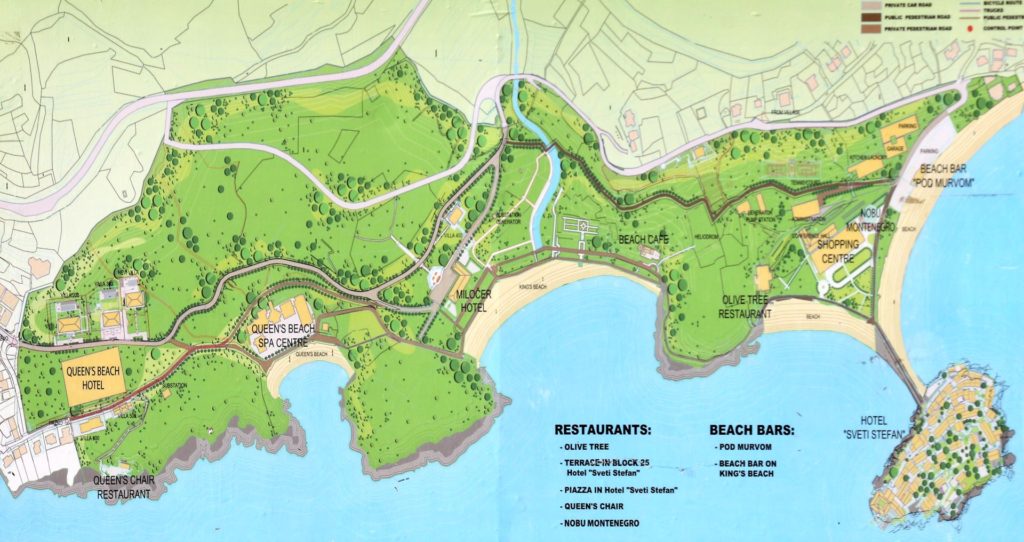 I do have beautiful memories of this area: several decades ago, when I was living in Budva, I often went there for a walk with my children. I remember the green Miločer Park full of flowers, the charming Queen’s Beach lined by tall cypresses and the famous five-star hotel resort of Sveti Stefan. But times have changed…..
I do have beautiful memories of this area: several decades ago, when I was living in Budva, I often went there for a walk with my children. I remember the green Miločer Park full of flowers, the charming Queen’s Beach lined by tall cypresses and the famous five-star hotel resort of Sveti Stefan. But times have changed…..
In 2007, the picturesque islet village of Sveti Stefan (with a surface of 14,400 square meters) was taken over by the company of Aman Resorts, on the base of a 30-year lease contract that was concluded with the Government of Montenegro. The refurbished resort officially opened in 2010 under the ownership of Adriatic Properties.
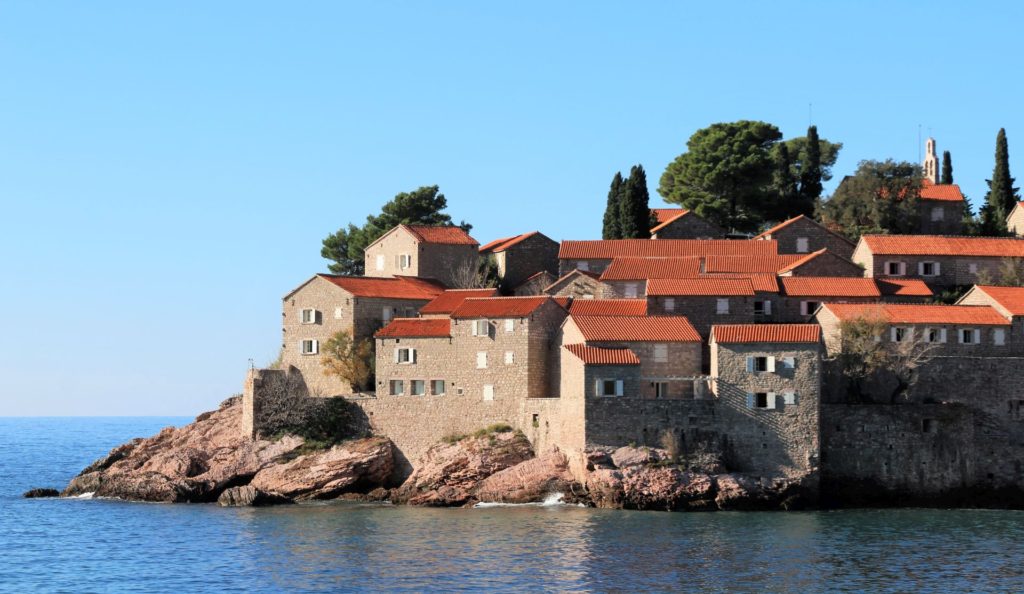 Aman Sveti Stefan incorporates two kilometers of coastline, including the pink sandy beaches of Sveti Stefan, Miločer Beach and the famous Queen’s Beach, which is backed by the resort’s expansive Aman Spa Center. The historical exterior of Sveti Stefan has remained largely unchanged, but the resort’s interiors have been restored and updated to meet top expectations.
Aman Sveti Stefan incorporates two kilometers of coastline, including the pink sandy beaches of Sveti Stefan, Miločer Beach and the famous Queen’s Beach, which is backed by the resort’s expansive Aman Spa Center. The historical exterior of Sveti Stefan has remained largely unchanged, but the resort’s interiors have been restored and updated to meet top expectations.
Of course, local citizens and occasional visitors were not happy when “Adriatic Properties” decided to block the scenic walking trail along the seacoast. Apart from the guests of Sveti Stefan and Villa Miločer, nobody was allowed to enjoy the exceptional beauty of this historical park. Yes, the investor did construct a path above the Queen’s Beach complex, but unfortunately, the romantic Queen’s Beach itself remains hidden from the eyes of those who pass by.
 We parked our car above the Sveti Stefan complex (€2.00 per hour) and enjoyed the splendid view of the hotel resort in the autumn sun. We were curious: would it be possible to visit the island? Once, in the old times, I remember that we could enter the island for a small fee – during special opening hours – but this has not been possible since the takeover by Aman Resorts.
We parked our car above the Sveti Stefan complex (€2.00 per hour) and enjoyed the splendid view of the hotel resort in the autumn sun. We were curious: would it be possible to visit the island? Once, in the old times, I remember that we could enter the island for a small fee – during special opening hours – but this has not been possible since the takeover by Aman Resorts.
It was a surprise to see two guards waiting at the entrance to the narrow embankment. They invited us to make a private guided walking tour around the island, at a price of ….. € 20.00 per person. Wow!!! Yes, they would take us along the narrow stone lanes lined by olive trees and Mediterranean vegetation, and we would also pass by the church and the main piazza – the heart and the soul of Sveti Stefan – with a view of the dramatic black-tiled clifftop pool. It was certainly an attractive offer, but in our opinion, the price was much too high, and unfortunately, there were no other options.
So we took a few pictures, we admired the two pink beaches and continued uphill – passing the famous Olive Tree Restaurant – to the gate of Miločer Park that was open to visitors.
 But let me tell you something more about the history of the stunning island of Sveti Stefan.
But let me tell you something more about the history of the stunning island of Sveti Stefan.
Sveti Stefan
It is assumed that Sveti Stefan was built and fortified by the Paštrović tribe in the 16th century after they looted Turkish ships moored in front of Jaz Beach. The fortress, with twelve houses built for each of the twelve Paštrović families, was surrounded by walls and served as a shelter in case of attacks by Turks and pirates. The fortress got the name Sveti Stefan (Saint Stephen), after the name of the church on the island.
In the 1800s, the village had around 400 inhabitants. However, by the end of the 19th and at the beginning of the 20th century, many inhabitants left and emigrated overseas.
 By 1955, there were just 20 people living on the island. They were moved to the mainland and the adaptation and renovation of the abandoned houses started in 1954. By 1957, the island was turned into a unique hotel-village – the most attractive and luxurious hotel complex in the Adriatic and the Mediterranean, intended for tourism at the highest level. The renovation was done expertly, so the buildings from the outside looked exactly as they were before, while the inside spaces were richly decorated and turned into luxurious apartments.
By 1955, there were just 20 people living on the island. They were moved to the mainland and the adaptation and renovation of the abandoned houses started in 1954. By 1957, the island was turned into a unique hotel-village – the most attractive and luxurious hotel complex in the Adriatic and the Mediterranean, intended for tourism at the highest level. The renovation was done expertly, so the buildings from the outside looked exactly as they were before, while the inside spaces were richly decorated and turned into luxurious apartments.
By the 1970’s, Sveti Stefan had become famous for attracting the global jet set as well as Hollywood stars including Sophia Loren, Richard Burton, Elisabeth Taylor, Princess Margaret, Marilyn Monroe, Kirk Douglas and many others. It remained the most exclusive resort on the Montenegro coast until the 1990’s when it fell into decline during the break-up of the Yugoslav federation.
Miločer Park
It was a nice experience to walk through the pine forest over the steep cliffs. A few tourists and locals were enjoying the morning sun. The sea was deep blue and the view of the Budva Riviera was magnificent.
As I had not been here for a long time, it was a surprise to see that Villa Miločer and the King’s Beach in front of it had not changed at all. The alley with old and tall cypresses was still there and everything was well-kept and maintained. A guard was walking around and a family with young children was lying on the beach.
 It is interesting to know that Villa Miločer was built between 1934 nd 1936 as the summer residence of King Alexander Karadjordjević from Serbia. After World War II it was confiscated and later it was transformed into a five-star hotel, as it was located at one of the most attractive places on the Montenegrin coast. In 2008-2009, It was refurbished as part of the Aman Sveti Stefan resort. Surrounded by 800 olive trees, the property is laid out over a 32-hectare plot.
It is interesting to know that Villa Miločer was built between 1934 nd 1936 as the summer residence of King Alexander Karadjordjević from Serbia. After World War II it was confiscated and later it was transformed into a five-star hotel, as it was located at one of the most attractive places on the Montenegrin coast. In 2008-2009, It was refurbished as part of the Aman Sveti Stefan resort. Surrounded by 800 olive trees, the property is laid out over a 32-hectare plot.
We went down to the King’s beach and passed through a small tunnel, carved into the limestone cliffs and leading to a small „ponta“. I suppose that it was already used by the royal family…..
We continued our walk through the park, as we really hoped to see the famous Queen’s Beach, once used by Queen Marija Karađorđević… But no, this appeared to be impossible.
 In the meantime, the resort’s stand-alone Aman Spa Center, surrounded by beautiful gardens and overlooking the sea, was established just behind this beach. The renovated buildings of the Spa Center were covered with Canadian vine plants in beautiful red and yellow autumn colors, but big fences and dense vegetation prevented us from seeing the idyllic Queen’s Beach that was once accessible for everybody… A perfect place for a VIP holiday indeed!
In the meantime, the resort’s stand-alone Aman Spa Center, surrounded by beautiful gardens and overlooking the sea, was established just behind this beach. The renovated buildings of the Spa Center were covered with Canadian vine plants in beautiful red and yellow autumn colors, but big fences and dense vegetation prevented us from seeing the idyllic Queen’s Beach that was once accessible for everybody… A perfect place for a VIP holiday indeed!
By the way, there is also another construction project in the Miločer Park underway: the new five-star Queen’s Beach Hotel. The cost? 70 million euro!
Pržno
 North of the Miločer Park, which is still surrounded by the original stone walls and gates, is the small fishing village Pržno. Unfortunately, apart from the Maestral Hotel, many new houses and apartment buildings have been built here around the Pržno Bay during the last few decades.
North of the Miločer Park, which is still surrounded by the original stone walls and gates, is the small fishing village Pržno. Unfortunately, apart from the Maestral Hotel, many new houses and apartment buildings have been built here around the Pržno Bay during the last few decades.
But the romantic beach with the little island is still worth a visit. The beach is lined by a few small pubs and fish restaurants with picturesque decorations. Pržno is a nice place, but it is very crowded during the summer. Fortunately, this time we were the only visitors.
We enjoyed the walk back to Sveti Stefan and admired the Mediterranean vegetation: Lebanese cedar, pine trees, mimosa, eucalyptus and agave…. with beautiful views of the sea, the island and the scenic nature of the area.
Altogether, we had a nice autumn walk and it was a real joy to visit the Miločer Park after such a long time!
Thank you for this (and all your previous posts). It is great to read articles about Montenegro either off the beaten track or, as in this post, about a tourist destination but off season.
So far I have only seen the coast down to Budva and none of the inland (except from the plane window when flying north to Belgrade). However, your posts really make me want to explore more of Montenegro. Thank you!
[…] picturesque island-village of Sveti Stefan was built and fortified in the 16th century by the Paštrović tribe as a shelter in case of […]